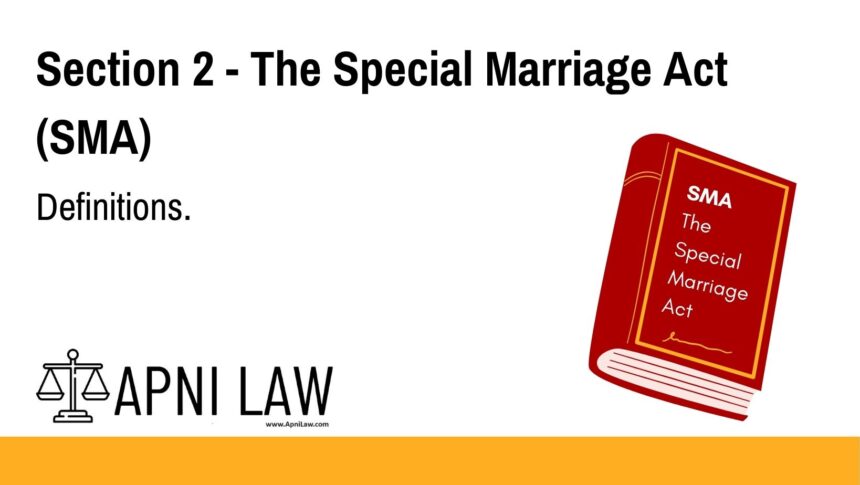Code: Section 2 of the Special Marriage Act, 1954
In this Act, unless the context otherwise requires:
(b) “degrees of prohibited relationship” — a man and any of the persons mentioned in Part I of the First Schedule and a woman and any of the persons mentioned in Part II of the said Schedule are within the degrees of prohibited relationship.
Explanation I — Relationship includes:
(a) relationship by half or uterine blood as well as by full blood;
(b) illegitimate blood relationship as well as legitimate;
(c) relationship by adoption as well as by blood;
and all terms of relationship in this Act shall be construed accordingly.
Explanation II — “Full blood” and “half blood”: Two persons are said to be related to each other by full blood when they are descended from a common ancestor by the same wife, and by half blood when they are descended from a common ancestor but by different wives.
Explanation III — “Uterine blood”: Two persons are said to be related to each other by uterine blood when they are descended from a common ancestress but by different husbands.
Explanation IV — In Explanations II and III, “ancestor” includes the father and “ancestress” the mother.
(d) “district” in relation to a Marriage Officer, means the area for which he is appointed as such under sub-section (1) or sub-section (2) of Section 3.
(e) “district court” means, in any area for which there is a city civil court, that court, and in any other area, the principal civil court of original jurisdiction, and includes any other civil court which may be specified by the State Government by notification in the Official Gazette as having jurisdiction in respect of the matters dealt with in this Act.
(f) “prescribed” means prescribed by rules made under this Act.
(g) “State Government”, in relation to a Union territory, means the administrator thereof.
Explanation of Section 2 of the Special Marriage Act
Section 2 of the Special Marriage Act provides critical definitions that are used throughout the Act. Understanding these terms is essential to interpreting the provisions correctly.
Key Terms Defined:
- Degrees of Prohibited Relationship: The Act prohibits marriages between people who are closely related, as listed in the First Schedule. This ensures that marriages do not occur within certain familial relationships.
- Relationship: Includes full blood, half blood, uterine blood, adoption, and illegitimate relationships. This inclusive definition aims to close loopholes that might otherwise allow such prohibited relationships.
- District: Refers to the area of jurisdiction for a Marriage Officer, as defined in Section 3 of the Act.
- District Court: Defined based on the presence of city civil courts or principal civil courts, and may include other courts as notified by the State Government.
- Prescribed: Means rules framed under the Act.
- State Government: In the context of Union territories, this refers to the administrator appointed by the central government.
Illustration
Example 1: Prohibited Relationship
A man seeks to marry his niece. According to the First Schedule and Section 2(b) of the Special Marriage Act, this falls within the “degrees of prohibited relationship” and is not permitted under the Act.
Example 2: Half Blood and Marriage Eligibility
Two individuals share a common father but have different mothers. They are related by half blood, and if their relationship is listed in the First Schedule, they cannot legally marry under the Act.
Common Questions and Answers on Section 2 SMA
1. What is meant by “degrees of prohibited relationship”?
It refers to relationships listed in Part I (for men) and Part II (for women) of the First Schedule. Marriages within these relationships are not permitted under the Act.
2. Why does the Act define full blood, half blood, and uterine blood?
These definitions help courts determine the legitimacy of a marriage and whether the parties fall under prohibited relationships.
3. What does “district” mean for the purposes of marriage registration?
It refers to the geographical area assigned to a Marriage Officer, where he or she has the authority to solemnize or register marriages.
4. Who is considered the “State Government” in a Union Territory?
In Union Territories, the term “State Government” refers to the Administrator appointed by the Central Government.
Conclusion
Section 2 of the Special Marriage Act, 1954 provides the definitional backbone of the legislation. By clarifying key terms such as “prohibited relationship,” “district,” and “district court,” it ensures consistency and clarity in legal proceedings under the Act. These definitions are crucial for individuals seeking to marry under this secular and progressive law.
For more detailed legal explanations and resources, visit ApniLaw.








